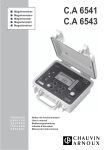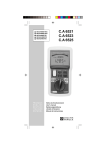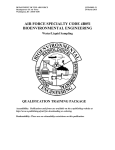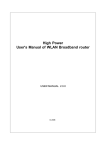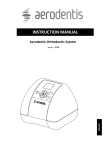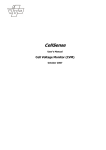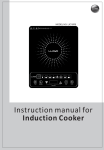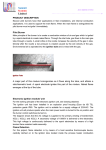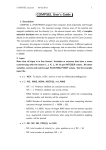Download C.A 6531 C.A 6533
Transcript
■ ■ ■ ■ C.A 6531 C.A 6533 MEGOHMMETRES MEGOHMMETERS MEGOHMMETER MEGAOHMMETRI ■ MEGAÓHMETROS FRANÇAIS ENGLISH DEUTSCH I TA L I A N O E S PA N O L Notice de fonctionnement User's manual Bedienungsanleitung Libretto d’Istruzioni Manual de Instrucciones 1 English Meaning of the symbol Warning ! Please refer to the User’s Manual before using the instrument. In this User’s Manual, the instructions preceded by the above symbol, should they not be carried out as shown, can result in a physical accident or dammage the instrument and the installations. Meaning of the symbol This device is protected by a double insulation or by a reinforced insulation. No linking is required from the protection earth terminal to ensure the electrical security. symbol Meaning of the Warning ! Risk of electric shock. The voltage of the parts marked with this symbol may be dangerous. For safety reasons, this symbol will light up on the LCD screen as soon as a voltage is generated. Thank you for purchasing a C.A 6531 or C.A 6533 insulation tester. To get the best service from this instrument : ■ read this user’s manual carefully ■ respect the safety precautions detailed PRECAUTIONS FOR USE ■ Comply with the conditions for use : temperature, humidity, altitude, degree of pollution and place of use ■ This instrument can be used on category-III installations for voltages not exceeding 600 V in relation to the earth. Category III meets severe reliability and availability requirements, corresponding to permanent use on fixed industrial installations (see IEC 1010-1 + A2). ■ Use connection accessories that comply with the applicable IEC safety standards, with a minimum voltage and voltage surge category at least equal to those that you use for your measurements. ■ Respect the value and type of the fuse to avoid damaging the instrument and cancelling the warranty. ■ Set the switch to OFF when the instrument is not in use. ■ Do not perform any insulation or resistance measurements when the presence of a voltage is indicated. ■ Check that none of the terminals is connected and that the switch is set to OFF before opening the instrument. 23 CONTENTS 1. PRESENTATION ................................................ 26 1.1 General Presentation ................................................... 26 1.1.1 The Megohmmeter .......................................... 26 1.1.2 Accessories ..................................................... 26 2. DESCRIPTION ................................................... 27 2.1 Housing ......................................................................... 27 2.1.1 C.A 6531 .......................................................... 27 2.1.2 C.A 6533 .......................................................... 27 Display .......................................................................... 27 2.2.1 Symbols ........................................................... 27 2.2.2 Bargraph .......................................................... 28 2.2.3 Digital display ................................................... 28 Control keyboard .......................................................... 28 2.3.1 Yellow key ........................................................ 28 2.3.2 ALARM key ...................................................... 28 2.3.3 Key ............................................................. 28 2.3.4 Key ............................................................. 29 2.3.5 Key ............................................................ 29 2.3.6 DREL key ......................................................... 29 2.2 2.3 3. MEASUREMENT FUNCTIONS ......................... 29 3.1 3.2 3.3 3.4 3.5 Insulation ...................................................................... 29 3.1.1 AC / DC voltage measurement ........................ 29 3.1.2 Insulation Measurement .................................. 30 Resistance .................................................................... 30 Capacitance (C.A 6531) ............................................... 31 AC / DC current (C.A 6531) .......................................... 31 AC voltage (C.A 6531) .................................................. 31 4. SPECIAL FUNCTIONS ...................................... 31 4.1 4.2 Start/stop ...................................................................... 31 Automatic shutdown ..................................................... 32 4.2.1 Deactivation of the automatic shutdown function ............................................ 32 Autotests ....................................................................... 32 4.3.1 Power supply ................................................... 32 4.3.2 Fuse (C.A 6531) .............................................. 32 Buzzer ........................................................................... 32 4.4.1 The different audible signals ........................... 32 4.4.2 Deactivation of the buzzer ............................... 33 Alarm thresholds .......................................................... 33 4.5.1 Programming of the alarm thresholds ............. 33 4.5.2 Activation/deactivation of the alarm thresholds .................................... 34 4.5.3 Triggering of the alarm ..................................... 34 Relative measurements (DREL) ................................... 34 Programming the capacitance per unit length (C.A 6531) ............................................ 34 4.3 4.4 4.5 4.6 4.7 24 5. USE .................................................................... 35 5.1 5.2 5.3 5.4 5.5 AC / DC voltage and insulation measurement ............. 35 Resistance measurement ............................................ 36 Capacitance measurement (C.A 6531) ........................ 36 AC / DC current measurement (C.A 6531) .................. 36 AC voltage measurement (C.A 6531) .......................... 36 6. SPECIFICATIONS ............................................. 37 6.1 6.2 Reference conditions .................................................... 37 Characteristics per function .......................................... 37 6.2.1 Voltage ............................................................. 37 6.2.2 Insulation ......................................................... 37 6.2.3 Resistance ....................................................... 38 6.2.4 Capacitance (C.A 6531) .................................. 38 6.2.5 Distance (C.A 6531) ........................................ 38 6.2.6 AC / DC current (C.A 6531) ............................. 38 6.2.7 AC voltage (C.A 6531) ..................................... 39 Power supply ................................................................ 39 Climatic conditions ....................................................... 39 Variations in nominal field of use ................................. 40 Limits ............................................................................ 40 Construction specifications .......................................... 40 Compliance with international standards ..................... 40 6.8.1. Electromagnetic compatibility: EC compliance 41 6.8.2. Mechanical protection ..................................... 41 6.3 6.4. 6.5. 6.6. 6.7. 6.8. 7. MAINTENANCE ................................................. 41 7.1. Upkeep .......................................................................... 41 7.1.1. Replacing the batteries .................................... 41 7.1.2. Replacing the fuse (C.A 6531) ........................ 41 7.1.3. Cleaning ........................................................... 42 7.1.4. Storage ............................................................ 42 7.1.5. Calibration ........................................................ 42 7.2. Maintenance ................................................................. 42 8. WARRANTY ...................................................... 42 9. TO ORDER ........................................................ 43 10. ATTACHMENT ................................................ 107 10.1 Front views ................................................................ 10.1.1. C.A 6531 ...................................................... 10.1.2. C.A 6533 ...................................................... 10.2. Examples of applications .......................................... 10.2.1. Insulation measurements on electrical installations .............................. 10.2.2. Measurement on electrical or telecom cable .... 10.2.3. Capacitance measurement between wires (C.A 6531) ............................ 10.2.4 Insulation measurements on motors ............ 10.3 Accessories ............................................................... 10.3.1. Shoulder bag ................................................ 10.3.2. Use of the shoulder bag ............................... 10.3.3. Remote control probe ................................... 25 107 107 108 109 109 110 111 112 113 113 113 114 1. PRESENTATION 1.1 General Presentation 1.1.1 The Megohmmeter These portable instruments function with batteries or a vehicle battery. They can be used to check insulation and voltages and to measure resistances. The C.A 6531 can also be used for: ■ measurement of the capacitance of a telephone line ■ current measurement ■ measurement of the pure alternating component of a DC voltage. These megohmmeters help to ensure the safety of electrical and telephone installations. The acquisition, processing and display of the measurements are managed by a microprocessor. They offer a wide range of advantages such as: ■ automatic detection of the presence of a dangerous voltage on the terminals in MW calibres (all insulation measurement blocked if U > 25 V), ■ protection of the instrument against external voltage surges, ■ operator safety by means of automatic discharge of the high voltage on the equipment tested, ■ display of the difference compared to a measurement value in memory, ■ measurement of the length of a telephone line according to its capacitance per km unit length (C.A 6531), ■ automatic shutdown of the instrument to save the batteries and indication of the battery charge, ■ fuse testing by periodic checks during current measurement (C.A 6531), ■ a large backlit LCD screen with a wide range of indicators making it very easy for the user to read. 1.1.2 Accessories ■ Carrying bag (part of standard delivery, see § 10) When placed in the carrying bag, the instrument can either be carried on the shoulder to transport it or around the neck for use. This leaves the users’ hands free to perform the measurements. Since the instrument is perpendicular to the chest, it is easy to read. At the bottom of the shoulder bag, underneath the instrument, there is a pocket for the leads, the touch prod, the crocodile clamp and the remote control probe. ■ Remote control probe (option, see § 10) This probe is plugged in to a special connector. It can be used for all the measurements, including activation of insulation testing, using the yellow button which works in exactly the same way as the button on the instrument. 26 A pushbutton on the back of the probe allows you to light the measuring point (approx. 500 lux). This function is very useful, since insulation testing is performed on installations with the power off! 2. DESCRIPTION 2.1 Housing See the diagrams of the instruments in § 10 (appendix at the end of this user’s manual) 2.1.1 C.A 6531 ➀ 3 safety terminals, Ø 4 mm (marked “mA”, “ + “ and “ - “) Next to the “ – “ terminal, there are two additional contacts for connecting the remote control probe (3-point connector). ➁ 7-position switch: OFF, MW - 50 V, MW - 100 V, 40 kW , 4000 nF, 400 mA, 400 V~ ➂ Keys: Yellow (to activate insulation measurement), ALARM, ➃ ➄ Backlit liquid crystal display Battery compartment + stand (not shown in the drawing) , , and DREL. 2.1.2 C.A 6533 2 x 4 mm Ø safety terminals (labelled “ + ” and “ G “), a 3point jack for the guarded lead or the remote control probe (labelled “ - “). ➀ ➁ 6-position switch: OFF, MW - 50 V, MW - 100 V, MW - 250 V, MW - 500 V, 400 kW ➂ Keys: yellow (to activate insulation measurement), ALARM, ➃ ➄ Backlit liquid crystal display Battery compartment + stand (not shown in the drawing) , 2.2 , and DREL. Display 2.2.1 Symbols ALARM Threshold active or threshold programming in progress > < Upper threshold Lower threshold Dangerous voltage generated (only comes on if test at 50 V) See the user’s manual > 25 V D REL Voltage > 25 V present on the instrument’s terminals Difference between actual measurement and measurement in memory (does not function for voltage on the MW positions) 27 Buzzer active P Constant operation (no automatic shutdown) Batteries flat 2.2.2 Bargraph Insulation > 1.1 GW Insulation < 70 kW 2.2.3 Digital display BAT Batteries low – must be changed OL Range exceeded --Insulation < 10 kW at 50 V, < 20 kW at 100 V, < 50 kW at 250 V, < 100 kW at 500 V 2.3 Control keyboard 2.3.1 Yellow key When this yellow key is pressed, a high voltage is generated for insulation testing. However, if a voltage greater than 25 V has been detected, no insulation testing is allowed and the key becomes inactive. The instrument remains in voltage measurement mode. 2.3.2 ALARM key The ALARM key can be used to activate/deactivate the alarm thresholds during insulation and resistance measurements. When associated with the and keys, it can be used to program the values of these thresholds. Key 2.3.3 This key can be used to program: ■ The alarm thresholds (with the ALARM key) By pressing the key, you can make the following elements flash, successively: - the measurement unit digit (if there is one), - the thousands digit, - the hundreds digit, - the tens digit, - the units digit, - the decimal separators, - the type of threshold (upper or lower), - and it then returns to the measurement units. ■ The capacitance per unit length in nF/km (with the key on the CA 6531). By pressing the key, you can make the following elements flash, successively: - the tens digit, - the units digit, - and it then returns to the tens digit. 28 2.3.4 Key When programming the alarm thresholds, the key can be used to scroll through all the possible values of the flashing elements and then loop back to the beginning: ■ MW or GW for insulation, kW or W for resistance, for the measurement units, ■ 1,2, 3 or _ for the thousands digit, ■ 0, 1, 2, 3, 4, 5, 6, 7, 8 and 9 for the hundreds, tens and units, ■ “-.- - -” or “- -.- -” or “- - -.-” or “- - - -” for the decimal separator, ■ > or < for the upper or lower threshold. When programming the capacitance per unit length in nF/km, the key can be used to change the values of the flashing digits to 0, 1, 2, 3, 4, 5, 6, 7, 8 or 9. 2.3.5 Key ■ C.A 6531 and C.A 6533 When this key is pressed, the backlighting of the display comes on. It will be turned off automatically one minute later. When it is lit, you can turn the backlighting off by pressing this key again. ■ C.A 6531 When the switch is on 4000 nF, a long press on this key enables you to program the unit length value (see 4.7). 2.3.6 D REL key A long press on this key enables you to memorize a value. The measurements that follow will be the positive or negative deviation compared with the value memorized (does not function for voltage on the MW positions). 3. MEASUREMENT FUNCTIONS 3.1 Insulation The insulation measurements correspond to the MW positions of the switch. 3.1.1 AC / DC voltage measurement As soon as the switch is set to one of the MW positions, the instrument measures the voltage between its + and - terminals. The value of this voltage is displayed (0 to 600 V AC / DC max.). If the voltage present is less than 25 V, the insulation can be tested, but the lower the test voltage the greater the possibility of error. If the voltage is greater than 25 V, “ > 25 V “ is displayed. Pressing the yellow key does not trigger insulation measurement, but causes a series of buzzes (buzz, buzz, buzz, ...) and makes the symbol flash until the yellow key is released. 29 These warnings only end if the voltage falls below 25 V (disconnection of the leads or removal of the voltage) or if the yellow key is released or, naturally, if you turn off the instrument by returning the switch to the OFF position. The instrument indicates if the value measured is outside its measurement range. Above 600 V, the digital display indicates OL. 3.1.2 Insulation Measurement If there is not a dangerous voltage (see § 3.1.1.), the user can then measure the insulation by pressing the yellow key. The high voltage is then generated between the terminals (marked + and -). The value of the measurement is shown on the logarithmic scale of the bargraph and on the digital display, with the corresponding MW or GW symbol. As soon as the yellow key is released, the instrument returns to voltage measurement mode. If the voltage generated may be dangerous, the is displayed. symbol The instrument indicates if the value measured is outside its measurement range. If the insulation resistance is greater than 400 MW (C.A 6531), 2 or 20 GW (C.A 6533), the OL symbol is displayed on the digital measurement display. When the measurement is greater than 1.1 GW (even on the C.A 6531), the symbol lights up on the right-hand side of the bargraph. Similarly, the digital measurement display indicates “ - - - “ if the insulation resistance is less than: ■ C.A 6531 10 kW at 50 V or 20 kW at 100 V ■ C.A 6533 10 kW at 50 V, or 20 kW at 100 V, or 50 kW at 250 V, or 100 kW at 500 V W , only the symbol When the measurement is less than 70 kW lights up on the left-hand side of the bargraph. To measure high insulation values, you are advised to use the “G“ guard terminal to remove the influence of superficial leak currents and “hand capacitance” (see § 10.2.2). 3.2 Resistance Resistance measurement corresponds to the 40 kW position of the switch on the C.A 6531 and the 400 kW position on the C.A 6533. The measurement is indicated on the digital measurement display, accompanied by the W or kW symbol if necessary. The instrument indicates if the value measured is outside its measurement range. If the resistance is greater than 40 kW or 400 kW , depending on the instrument, the OL symbol is displayed on the digital measurement display. A programmed threshold may trigger an alarm (see § 4.5). 30 3.3 Capacitance (C.A 6531) Capacitance measurement corresponds to the 4000 nF position of the switch. The measurement is shown on the display accompanied by the nF symbol. The length of the telephone line measured is indicated in km on the digital threshold display, according to the programmed capacitance per unit length. If the leads are set up in a short circuit, the instrument indications OL on the digital measurement display and the distance is - - - km. If the capacitance measurement is greater than 4000 nF, the OL symbol is displayed on the digital measurement display. If the distance measurement is greater than 80 km, the OL symbol is displayed on the digital measurement display. If the leads are not connected, the digital measurement display indicates 0.00 and - - - - km. 3.4 AC / DC current (C.A 6531) Current measurement corresponds to the 400 mA position of the switch. The measurement is shown on the display accompanied by the mA symbol. The fuse is checked periodically. If the current measurement is greater than 400 mA AC / DC, the OL symbol is displayed on the digital measurement display. If the value of the current is negative, the instrument detects that the fuse is not functional, only at the end of measurement. It is advised therefore to swap over the leads so as to always have a positive current measurement. 3.5 AC voltage (C.A 6531) AC voltage measurement corresponds to the V~ position of the switch. The measurement is shown on the display accompanied by the V AC symbol. In this function, the DC component is not measured. If the voltage measurement is greater than 400 V AC, the OL symbol is displayed on the digital measurement display. 4. SPECIAL FUNCTIONS 4.1 Start/stop When you move the switch from the OFF position to one of the active positions, the instrument is started up. All the display segments light up at the same time for 1 second. Then all the segments go out except (for 2 seconds) the , and symbols which delimit the size of the bargraph. The bargraph indicates the battery charge life and the digital measurement display indicates the charge life available (0.00 to 1.00 = 0 to 100%). The instrument can be shut down at any time by resetting the switch to OFF. 31 . 4.2 Automatic shutdown After 5 minutes without any activity by the user on the instrument (key press on the keyboard or on the yellow key on the remote control probe or turn of the rotary switch), the instrument shuts down automatically. It is then on standby. When this is the case, to start up the instrument again, all you have to do is press one of the keys, turn the switch or press the yellow key on the remote control probe. 4.2.1 Deactivation of the automatic shutdown function button whilst switching on the device with the Press the rotating switch. The P displayed indicates that the device is in continuous use mode. To reactivate the automatic shutdown function, switch the instrument off (turn the switch to OFF) and then switch it back on again. 4.3 Autotests 4.3.1 Power supply The power supply voltage is measured automatically once every second. The voltage range ensuring correct operation is between 7 V and 10 V. Depending on the result of the autotest, there are four possible cases: ■ The voltage is correct: The symbol is not displayed on the screen. ■ The remaining charge life is low (U < 7.1 V): the symbol flashes. ■ Measurement accuracy is no longer guaranteed - change symbol remains lit the batteries (U £ 6,9 V): the continuously. ■ The voltage is close to interrupting operation of the clock (U < 6.7 V): the digital display indicates BAT and then, after 5 seconds, the shutdown buzzer sounds and the automatic shutdown function is activated. The instrument shuts down. 4.3.2 Fuse (C.A 6531) The fuse is automatically tested when switching on the instrument and at the end of each current measurement. 4.4 Buzzer 4.4.1 The different audible signals When the symbol is displayed, the buzzer is active. It gives out different audible signals, depending on the situation. ■ Short buzz (65 ms at 2 kHz) in the following cases: - press on a key - automatic shutdown ■ Continuous buzz (at 2 kHz) in the following cases: - when the measurement is lower than the minimum threshold, - when the measurement is higher than the maximum threshold. 32 ■ Short, higher buzz (65 ms at 4 kHz) when an inactive key is pressed. ■ Series of short, high buzzes (4 kHz) if the voltage measured is greater than 25 V and the user is pressing the yellow key. 4.4.2 Deactivation of the buzzer Press the ALARM button when switching on the device with the rotating switch. symbol is no longer displayed. The To reactivate the buzzer, switch the instrument off and then back on again. 4.5 Alarm thresholds Thresholds can only programmed for insulation and resistance measurement. The thresholds can be upper or lower thresholds. They can be active or inactive and will be stored in the memory even after the instrument has been switched off. 4.5.1 Programming of the alarm thresholds You can select the threshold programming mode by a long press on the ALARM key. The ALARM symbol is displayed and the value of the threshold corresponding to the switch position is indicated on the digital threshold display. If no value was programmed previously, the display indicates a default threshold: ■ On the C.A 6531 > 0.050 MW for the MW - 50 V position > 0.100 MW for the MW - 100 V position < 10.00 kW for the 40 kW position ■ On the C.A 6533 > 0.05 MW for the MW - 50 V position > 0.10 MW for the MW - 100 V position > 0.25 MW for the MW - 250 V position > 0.50 MW for the MW - 500 V position < 10.00 kW for the 400 kW position At this moment, it is possible to program the threshold using the (see § 2.3.3) and keys (see § 2.3.4). During this programming, if you change the switch position, you lose what you have just done. You can quit the programming mode and record the threshold by another long press on the ALARM key. If the programmed threshold is too high, it is corrected when it is stored in the memory: the maximum value is entered. For example, a 2 GW insulation threshold will be stored in the memory as 399.9 MW on the C.A 6531, while for resistance measurement 700 kW will become 399.9 kW on the C.A 6533. 33 If the threshold has been “wrongly” programmed, it is corrected when it is stored in the memory: For example, 002 MW will become 2.00 MW . 4.5.2 Activation/deactivation of the alarm thresholds The threshold corresponding to the switch position can be activated by a short press on the ALARM key. The ALARM symbol, the < or > symbol, the programmed value of the threshold and the corresponding unit are then displayed on the digital threshold display. The threshold can be deactivated by a second short press on the key. The ALARM symbol, the < or > symbol, the programmed value of the threshold and the corresponding unit disappear. If the D REL function is on and you activate a threshold, it will apply to the absolute value of the value displayed. 4.5.3 Triggering of the alarm Examples in insulation measurement: ■ If an upper threshold of 100 MW W is active, the display indicates “ALARM > 100.0 MW ”. If the measurement exceeds this value, a continuous beep will be triggered and the whole digital threshold display will flash. ■ If a lower threshold of 100 MW W is active, the display indicates “ALARM < 100.0 MW ”. If the measurement falls below this value, a continuous beep will be triggered and the whole digital threshold display will flash. 4.6 Relative measurements (D DREL) Pressing the DREL key enables you to store the value measured in the memory. The measurements that follow are differences compared with the value in memory. These differences may be positive or negative. The DREL symbol is displayed. Another press clears the value from the memory and returns the instrument to normal mode. This key can be used at any time except in voltage mode W positions. on the MW 4.7 Programming the capacitance per unit length (C.A 6531) When the switch is set to nF, a long press on the key activates the programming mode for the capacitance per unit length of the line to be measured. The value in memory is displayed on the digital threshold display along with the nF/km symbol. If no value was programmed previously, the display indicates 50 nF/km by default. It is then possible to modify the value present (see § 2.2.3). 34 During programming, if you change the switch position, you lose what you have just done. You can quit the programming mode and record the value by another long press on the key. 5. USE To display the device software version and series number press the yellow button whilst switching on via the rotating switch. To start up the machine, set the rotary switch to the type of measurement to be performed and then connect the instrument to the installation to be tested. The unit is displayed and the calibre is selected automatically for the best reading. The instrument can be shut down manually by setting the switch to OFF. Otherwise, the instrument will be shut down automatically after 5 minutes without any sign of the presence of a user (see § 4.2). 5.1 AC / DC voltage and insulation measurement (see § 10.2 Examples of applications) ■ Start up the instrument by setting the switch to the MW position which will provide the required voltage. ■ Connect the lead from the “+” terminal to the cold point and the lead of the “-” terminal or the remote control probe to the hot point. ■ The instrument first measures the AC / DC voltage present between its terminals (see § 3.1.1). If there is no voltage > 25 V: ■ Press the yellow key, keeping it pressed down until the measurement is displayed. The yellow key on the remote control probe acts in exactly the same way as the yellow key on the instrument (see § 3.1.2). W ), you are To measure high insulation values (> 1 GW advised to use the “ G “ guard terminal to remove the influence of superficial leak currents and “hand capacitance” (see § 10.2.2). In this case, it is preferable to use crocodile clips or wire grips rather than touch prods held in the hand. ■ Note the value displayed. ■ When measurement has ended, release the yellow key and wait for the installation tested to discharge (voltage < 25 V) before disconnecting the leads. ■ If the digital value fluctuates greatly for large values (> 500 MW ) this means it is a highly capacitive load. In this case read the measurement from the bar graph. Note: The user can control the backlighting as required by pressing the key A programmed alarm threshold may be activated with the ALARM key (see § 4.5). 35 5.2 Resistance measurement ■ Start up the instrument by setting the switch to 40 kW (C.A 6531) or 400 kW (C.A 6533). ■ Connect the + and - leads to the measurement points. ■ Note the resistance value displayed (see § 3.2). Note: The user can control the backlighting as required by pressing the key. A programmed alarm threshold may be activated with the ALARM key (see § 4.5). 5.3 Capacitance measurement (C.A 6531) ■ Start up the instrument by setting the switch to 4000 nF. ■ Connect the + and - leads to the measurement points. ■ Note the capacitance value displayed (see § 3.3) and the length of the line after programming its capacitance per unit length. Note: The user can control the backlighting as required by pressing the key. 5.4 AC / DC current measurement (C.A 6531) ■ Start up the instrument by setting the switch to 400 mA. ■ Connect the leads from the mA and - terminals to the measurement points. The fuse is checked at start-up and after every measurement. ■ Note the current value displayed (see § 3.4). Note: The user can control the backlighting as required by pressing the key. 5.5 AC voltage measurement (C.A 6531) ■ Start up the instrument by setting the switch to V~. ■ Connect the + and - leads to the measurement points. ■ Note the voltage value displayed (see § 3.5). Note: The user can control the backlighting as required by pressing the key . 36 6. SPECIFICATIONS The instrument displays a measurement every 400 ms, which corresponds to 2.5 measurements per second for the digital display. The bargraph is refreshed every 100 ms. The digital measurement is smoothed, while the bargraph always indicates the instantaneous measurement. 6.1 Reference conditions Influence quantities Reference conditions Temperature 23 °C ± 3 K Relative humidity 45 to 55 % RH Supply voltage 8 V ± 0.2 V Frequency of measured voltage DC or 45 to 65 Hz Frequency of measured current DC or 45 to 65 Hz Capacity in parallel on resistance nil Electrical field nil Magnetic field < 40 A/m 6.2 Characteristics per function 6.2.1 Voltage Measurement range: 0 to 600 V AC/DC Frequency: DC and 15... 400 Hz Automatic calibres 0.0... 399.9 V AC/DC Resolution Accuracy Input impedance 400...599 V AC/DC 0.1 V 1V ± 3% R ±2 ct ± 3% R ±1 ct 4 MW (C.A 6531) - 300 kW (C.A 6533) 6.2.2 Insulation Measurement range: ■ C.A 6531: at 50 V at 100 V 10 kW to 400 MW 20 kW to 400 MW ■ C.A 6533: at 50 V at 100 V at 250 V at 500 V 10 kW to 2 GW 20 kW to 2 GW 50 kW to 20 GW 100 kW to 20 GW Analogue calibre Resolution 70 kW ...1.1 GW 8 segments per 10-unit interval Accuracy Models Digital calibres Resolution Accuracy 5 % R ± 1 segment C.A 6531 and C.A 6533 0.01 to 0.19 MW 0.20 to 39.99 MW 10 kW 40.0 to 399.9 MW 100 kW 3% R ± 5 ct 3% R ± 2 ct 37 C.A 6533 400 to 4.00 to 3999 MW 20.00 GW 1 MW 10 MW 5% R ±2ct Models C.A 6531 and C.A 6533 Test voltage Voltage at open circuit Test current C.A 6533 50 V 100 V 250 V 500 V < 75 V < 150 V < 300 V < 600 V ³ 1 mA for R £ 50 kW ³ 1 mA for R £ 100 kW ³ 1 mA for R £ 250 kW ³ 1 mA for R £ 500 kW Short-circuit current £ 3 mA The residual voltage present on the terminals when the yellow key is released is discharged through the instrument via the measurement leads in 3 to 6 s/µF according to the measurement for the C.A 6531 and in less than 2 s/µF for the C.A 6533. 6.2.3 Resistance Measurement range : 0 to 40 kW for the C.A 6531 0 to 400 kW for the C.A 6533 Models C.A 6531 and C.A 6533 Auto calibres Resolution Accuracy 0.0..399.9 W 400..3999 W 0.1 W 1W ± 3% R ± 2 ct Measurement current C.A 6533 4.00..39.99 kW 40.0..399.9 kW 10 W 100 W ± 3% R ± 1 ct 55 ou 550 µA according to the measurement Voltage at open circuit 7 V £ Uopen £ 9 V 6.2.4 Capacitance (C.A 6531) Measurement range: 0 to 4000 nF Calibre Resolution 0.00..399.9 nF 400..3999 nF 0.1 nF 1 nF Accuracy ± 2% R ± 1 ct Measurement current 55 ou 550 µA according to the measurement 6.2.5 Distance (C.A 6531) Measurement range: 0 to 80 km Calibre Resolution Accuracy 0.000...3.999 km 4.00...39.99 km 40.0...80.0 km 1m 10 m 100 m ± 2% R ± 2 ct ± 2% R ± 1 ct 6.2.6 AC / DC current (C.A 6531) ■ Measurement range: 0 to 399.9 mA AC / DC ■ Frequency: DC and 15...400 Hz ■ Resolution: 0.1 mA ■ Accuracy: ± 3% ± 2 ct ■ Internal impedance: 1 W 38 6.2.7 AC voltage (C.A 6531) ■ Measurement range: 0 to 399.9 V AC ■ Frequency: 10 Hz to 1 MHz ■ Resolution: 0.1 V AC ■ Accuracy: ± 3% R ± 3 ct ■ Internal impedance: 4 MW 6.3 Power supply The instruments are powered by 6 x 1.5 V alkaline batteries, type LR6. Average consumption* Average charge life Voltmeter (C.A 6531/6533) Ammeter (C.A 6531) 25 mA 57,600 5-seconds measurements Resistance (C.A 6531/6533) Capacitance meter (C.A 6531) 50 mA 28,000 5-seconds measurements Isulation(C.A 6531/6533) MW 50 V (R = 50 kW ) MW 100 V (R = 100 kW ) 90 mA 120 mA 15,000 5-seconds measurements 10,800 5-seconds measurements Isulation (C.A 6533) MW 50 V MW 100 V MW 250 V MW 500 V 140 mA 150 mA 130 mA 190 mA 8,800 5-seconds measurements 8,000 5-seconds measurements 9,800 5-seconds measurements Measurement 5,600 5-seconds measurements * Add approximately 45 mA when the backlighting is on. Humidity in % of HR (non-condensing atmosphere) 6.4. Climatic conditions Storage without battery Reference Use 90 80 70 60 50 40 30 20 10 0 -50 -40 -30 -20 -10 0 10 20 30 Temperature in °C 39 40 50 60 70 80 90 6.5. Variations in nominal field of use Influence quantities Operating range limits Measurement variations Typical Maximum Temperature -10 to + 55°C Relative humidity 20 to 80% HR 2% R ± 2 ct 3% R ± 2 ct Supply voltage 7 to 10 V (1% R ±1 ct)/V (2% R ±2 ct)/V DC and 15..400 Hz 1% R ±1 ct 2% R ±2 ct Negligible 1% R ±1 ct Frequency (inV and in mA) (1% R ±1 ct)/10°C (2% R ±2 ct )/ 10°C Capacity 0 to 5 µF at en parallel nominal current on the resistance 6.6. Limits The instrument is protected across all ranges against a constantly applied voltage, between any two terminals, of 600 V AC/DC on the C.A 6531, and 720 V AC/DC on the C.A 6533. The C.A 6531 is protected for 10 s against an accidental overvoltage of 720 V across all the ranges. The current input on the C.A 6531 accepts 0.63 A, beyond which it is protected by fuse. 6.7. ■ ■ ■ ■ ■ 6.8. ■ ■ ■ ■ ■ Construction specifications Overall dimensions of the unit (L x l x h): 211 x 108 x 60 mm Dimensions of the display: 73 mm x 54.3 mm Weight: approx. 835 g Materials: - Polycarbonate housing - Crystal polycarbonate screen - Elastomer external mouldings - Silicon keyboard. Stand: Enables the instrument to be tilted at 30°. It clips onto the bottom of the housing when not in use. Compliance with international standards Electrical safety: IEC 1010-1 + A2 (Nov. 95), IEC 61557 (Feb. 97) and DIN EN 61557. Dual insulation: Pollution level: 2 Installation category: III Rated voltage: 600 V 40 6.8.1. Electromagnetic compatibility: EC compliance Emission: NF EN 55 081 -1 (Ed. 92) ■ Immunity: NF EN 55 082 -1 (Ed. 95) ■ 6.8.2. Mechanical protection IP54 as per NF EN 60529 (Oct. 92) IK04 as per NF EN 50102 (June 95) 7. MAINTENANCE To display the device software version and series number press the yellow button whilst switching on via the rotating switch. For maintenance, use only specified spare parts. The manufacturer will not be held responsible for any accident occuring following a repair done other than by its After Sales Service or approved repairers. 7.1. Upkeep 7.1.1. Replacing the batteries Before performing any measurements, make sure that the symbol does not appear on the display after the start-up phase. If it does appear, you must change all the batteries, taking all the necessary precautions when you open the instrument. Check that none of the terminals is connected and that the switch is set to OFF before opening the battery compartment. The hatch is located on the back of the unit. It can be opened and closed using a coin or a large screwdriver (1/4-turn captive screw). To avoid errors, the symbol on the power-supply board shows the direction in which the 2 x 3 LR6 1.5 V batteries should be mounted. Make sure that you put the hatch back properly and close it after changing the batteries. 7.1.2. Replacing the fuse (C.A 6531) If “FUS” appears on the digital measurement display during the start-up phase or when measuring continuity, you must change the fuse, taking all the necessary precautions when opening the instrument. Check that none of the terminals is connected and that the switch is set to OFF before opening the battery compartment on the back of the instrument. It can be opened and closed using a coin or a large screwdriver (1/4-turn captive screw). The fuse is placed on a fuse carrier welded to the power-supply board. To avoid any errors, the text “F-0.63 A” is written next to the fuse carrier. Make sure that you replace the faulty fuse with a new fuse of the same rating and type and then replace and close the hatch. 41 Exact type of fuse: FF 0.63 A - 660 V - 6.3 x 32 mm - 30 kA (printed on the battery compartment label) 7.1.3. Cleaning The instrument must be disconnected from any source of electricity. Use a soft cloth slightly moistened with soapy water. Rinse with a wet cloth and dry quickly with a dry cloth or pulsated air. Do not use alcohol, solvents or hydrocarbons. 7.1.4. Storage If the instrument is not used for a long period (more than two months), remove the batteries and store them separately. 7.1.5. Calibration It is essential that all measuring instruments are regularly calibrated. We advise you to check this instrument at least once a year. For checking and calibration of your instrument, please contact our accredited laboratories (list on request) or the Chauvin Arnoux subsidiary or Agent in your country. 7.2. Maintenance Repairs under or out of guarantee: please return the product to your distributor 8. WARRANTY Our guarantee is applicable for 3 years (for C.A 6431 and C.A 6433) after the date on which the equipment is made available (extract from our General Conditions of Sale, available on request). 42 9. TO ORDER C.A 6531 ............................................................... P01.1408.04 Delivered with a shoulder bag for transport and hands-free use of the instrument and its accessories, 2 elbowed-straight safety leads (red +black), 1.5 m long 1 red crocodile clip, 1 black touch prod, 2 wire grips (red and black), 6 LR6 batteries and this 5-language user’s manual. C.A 6533 ............................................................... P01.1408.05 Delivered with a shoulder bag for transport and hands-free use of the instrument and its accessories, 2 elbowed-straight safety leads (red +black), 1.5 m long 1 x 1.5 m long guarded safety lead, triple banana plug. (black) 1 red crocodile clip, 1 blue crocodile, 1 black touch prod, 2 wire grips (red and black), 6 LR6 batteries and this 5-language user’s manual. Accessories: Remote control probe ........................................... P01.1019.35 Spare parts: ■ 2 elbowed-straight safety leads (red + black) 1.5 m long .................................... P01.2950.88 ■ 3 x 1.5 m long straight-straight safety leads (red, blue, guarded black) ................................. P01.2951.71 ■ 5 crocodile clips (red, black, blue, white, green/yellow) ............... P01.1018.49 ■ 2 wire grips (red and black) ............................... P01.1018.53 ■ 1 shoulder bag for transport and hands-free use ...................... P01.2980.49 ■ 1 set of 5 fuses 0,63 A ...................................... P01.2970.78 43






















